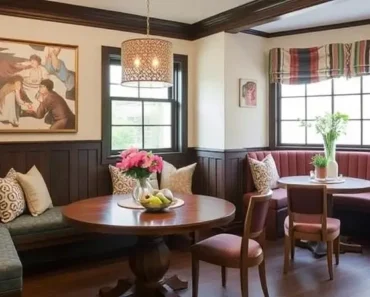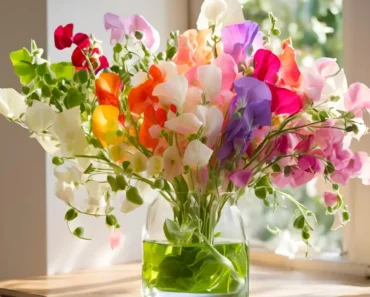Creating an expensive-looking home doesn’t require a massive budget or complete renovation. With strategic design choices and attention to detail, you can transform your space into a luxurious haven that rivals high-end showrooms. The key lies in understanding which elements create the perception of luxury and implementing them thoughtfully throughout your home.Making your home look expensive is about mastering the art of sophisticated styling, quality over quantity, and creating cohesive design elements that flow seamlessly from room to room. Small changes in lighting, color schemes, and furniture arrangement can dramatically elevate your space’s overall appearance and feel.
This comprehensive guide will walk you through proven strategies to make your home look expensive without breaking the bank. From simple DIY projects to strategic purchases, you’ll discover how to create an upscale aesthetic that reflects your personal style while maximizing your investment in your living space.
The Psychology Behind Expensive-Looking Spaces
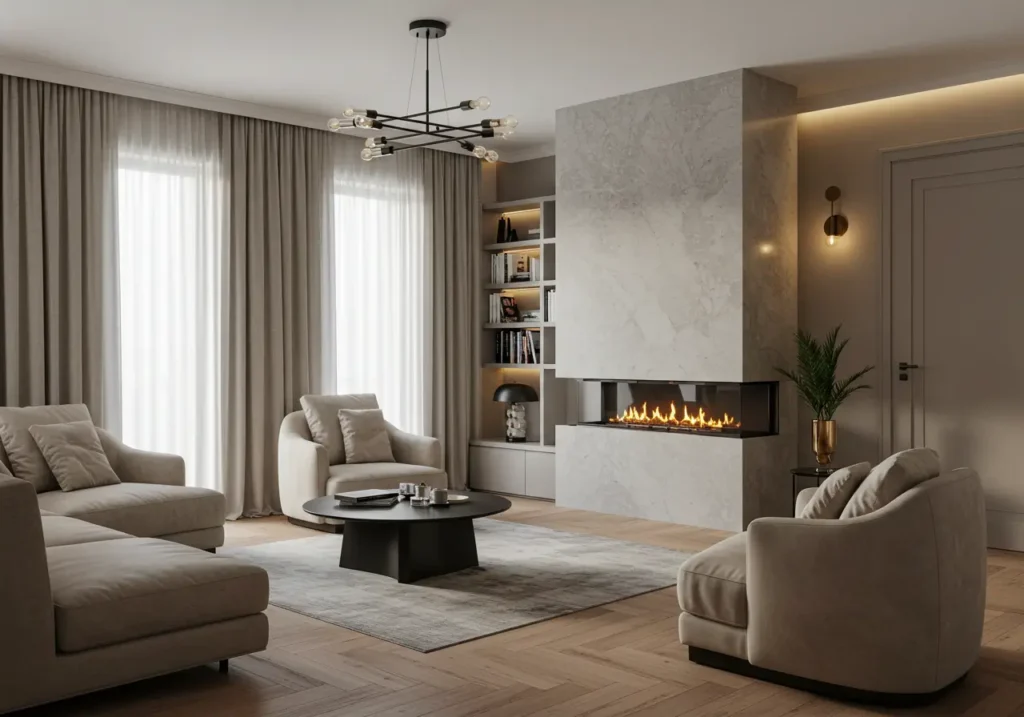
Understanding what makes a space appear expensive begins with recognizing the visual cues that our minds associate with luxury and quality. High-end spaces share common characteristics that signal sophistication and thoughtful design, regardless of the actual cost of individual items.
Expensive-looking homes typically feature clean lines, uncluttered spaces, and a sense of intentional design where every element serves a purpose. This doesn’t mean minimalism is required, but rather that each piece in the room contributes to the overall aesthetic without creating visual chaos.
Color coordination plays a crucial role in creating an expensive appearance. Luxury spaces often employ sophisticated color palettes with neutral bases and carefully chosen accent colors. This creates a sense of harmony and professionalism that immediately elevates the space’s perceived value.
Quality lighting is another hallmark of expensive-looking interiors. Professional lighting design creates ambiance, highlights architectural features, and eliminates harsh shadows that can make spaces feel cheap or institutional. The interplay of different light sources at various heights creates depth and visual interest.
Strategic Color Choices That Elevate Your Space
Neutral Foundation Palettes
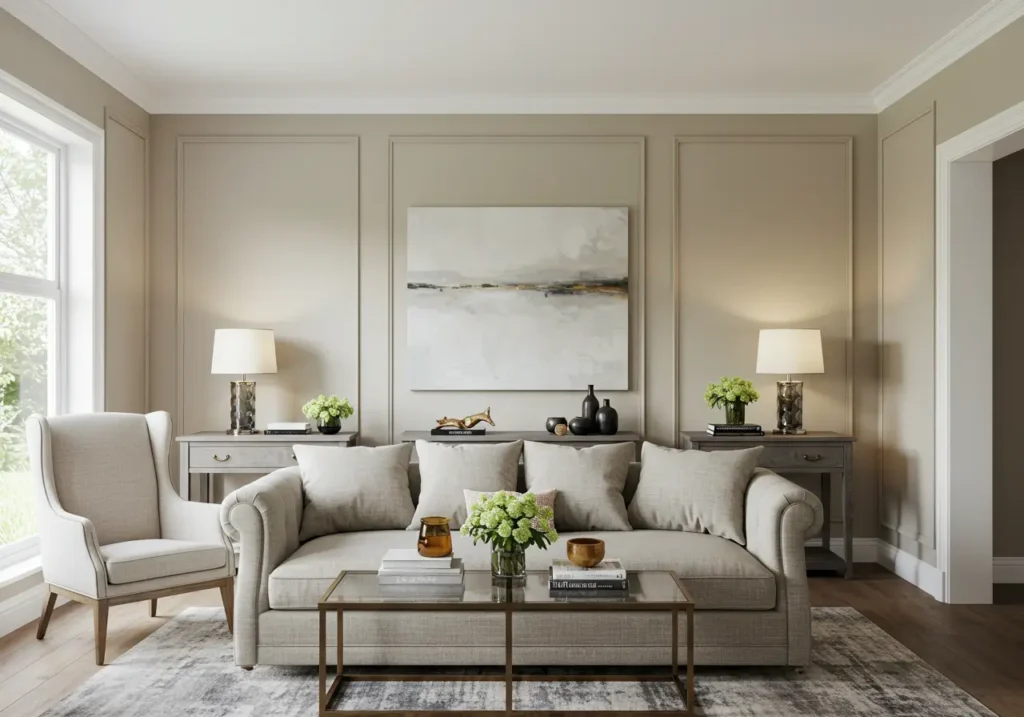
Expensive-looking homes often start with sophisticated neutral color schemes that provide a timeless foundation. Colors like warm whites, soft grays, beiges, and taupe create an elegant backdrop that allows furniture and accessories to shine without competing for attention.
These neutral palettes have staying power and won’t look dated in a few years, which is a hallmark of truly expensive design. They also provide flexibility for changing accent colors seasonally or as your preferences evolve, making them a smart long-term investment.
When selecting neutrals, pay attention to undertones. Warm neutrals with beige or yellow undertones create cozy, inviting spaces, while cool neutrals with gray or blue undertones feel more contemporary and crisp. Consistency in undertones throughout your home creates a cohesive, professionally designed appearance.
Accent Colors for Sophistication

Strategic use of accent colors can instantly elevate your space when chosen thoughtfully. Rich, saturated colors like deep navy, forest green, burgundy, or charcoal create sophisticated focal points without overwhelming the space.
Metallic accents in gold, brass, or copper add warmth and luxury to any room. These can be incorporated through hardware, light fixtures, picture frames, or decorative accessories. The key is maintaining consistency in your metallic choices throughout connected spaces.
Avoid using too many accent colors in one space. A general rule is to stick to a maximum of three colors plus neutrals in any given room. This creates visual harmony and prevents the space from feeling chaotic or amateur.
Paint Quality and Application
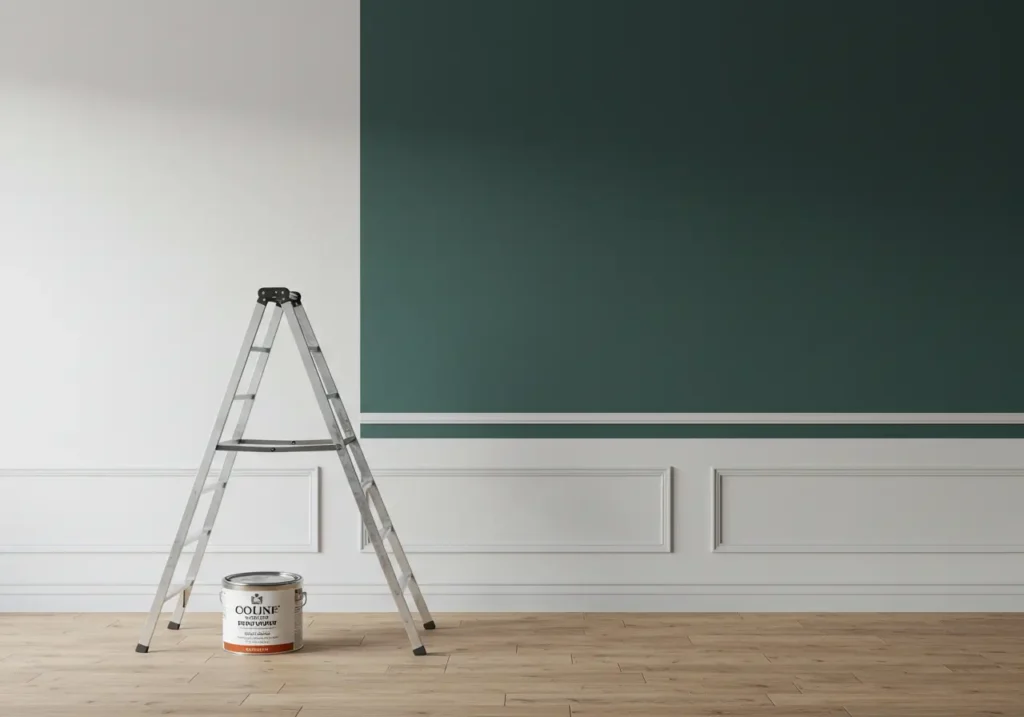
The quality of paint and its application significantly impacts how expensive your walls appear. Higher-quality paints provide better coverage, richer color, and a more professional finish that lasts longer and looks more luxurious.
Consider using different paint finishes strategically throughout your home. Eggshell or satin finishes on walls provide subtle elegance, while semi-gloss on trim and doors creates crisp, clean lines that mimic high-end millwork.
Professional-looking paint jobs require attention to detail in preparation and application. Properly filled holes, smooth surfaces, and clean, straight lines between colors and surfaces make an enormous difference in the final appearance, regardless of the paint’s actual cost.
Lighting Strategies for Luxury Appeal
Lighting has the power to transform any space from ordinary to extraordinary, making it one of the most cost-effective ways to make your home look expensive. The key is creating layers of light that serve different purposes and can be adjusted for various activities and moods.
Layered Lighting Approach
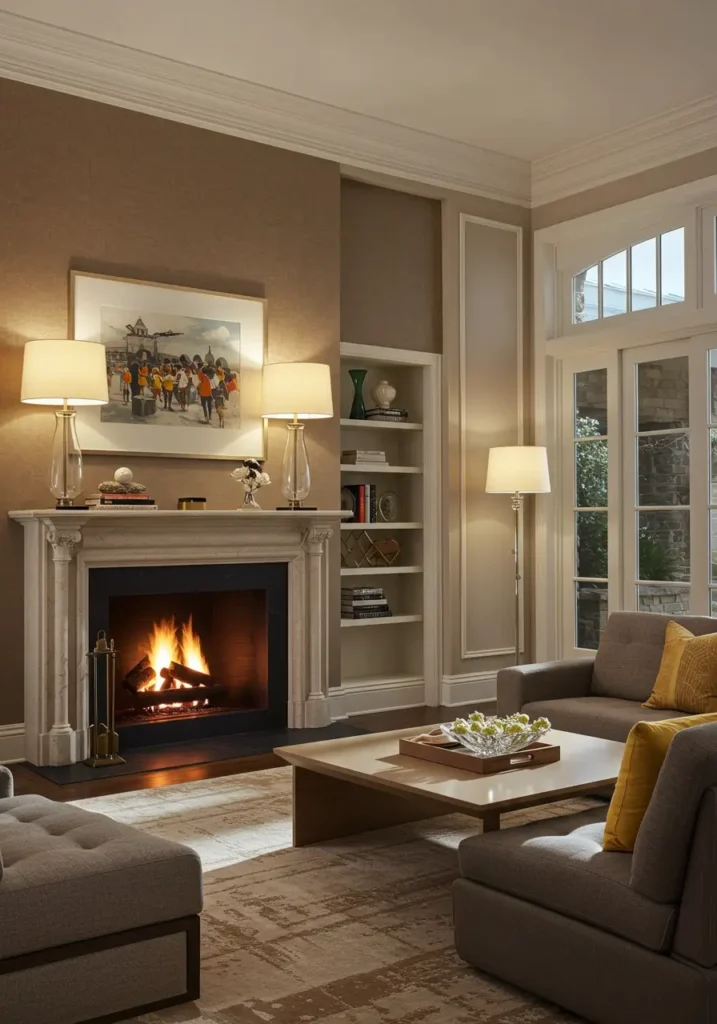
Professional designers use three types of lighting: ambient (general lighting), task (functional lighting), and accent (decorative lighting). Combining these three types creates depth and sophistication that single-source lighting cannot achieve.
Ambient lighting provides overall illumination and can come from ceiling fixtures, chandeliers, or strategically placed floor lamps. Task lighting focuses on specific activities like reading or cooking and includes table lamps, under-cabinet lighting, or pendant lights. Accent lighting highlights architectural features, artwork, or decorative elements through wall sconces, picture lights, or strategically placed spotlights.
The ability to control different lighting layers independently allows you to create various moods and atmospheres throughout the day, which is a hallmark of expensive, professionally designed spaces.
Statement Light Fixtures
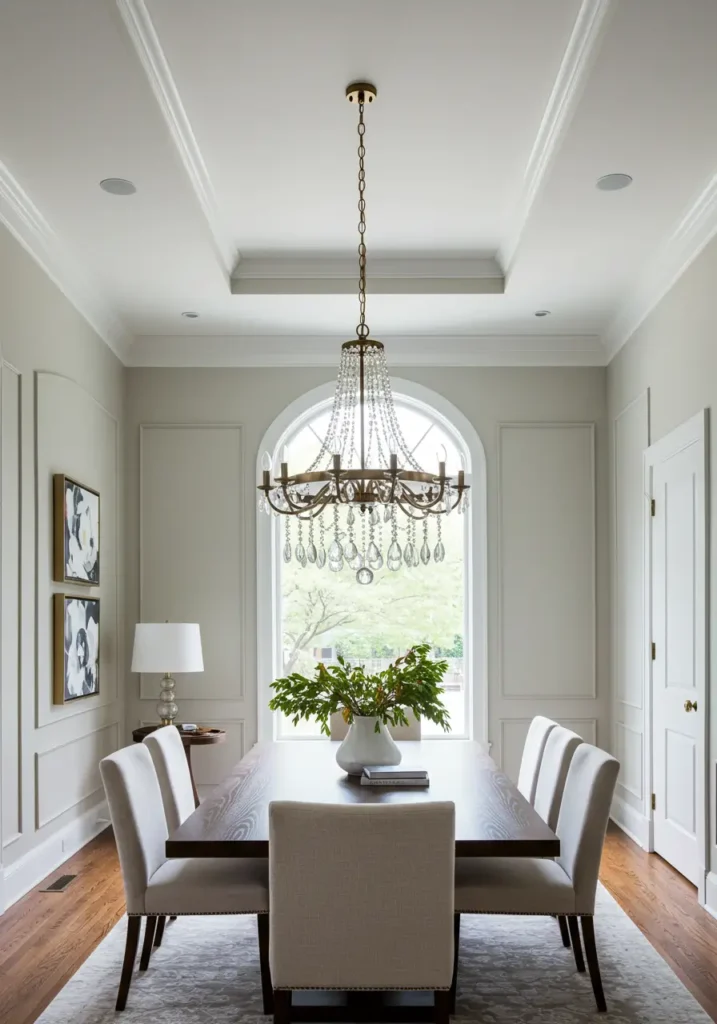
Investing in one or two statement light fixtures can dramatically impact your home’s perceived value. A beautiful chandelier in the dining room or an elegant pendant light in the entryway immediately signals attention to design and quality.
When selecting statement fixtures, consider scale and proportion. Oversized fixtures can make a dramatic impact, but they must be appropriately sized for the space. As a general rule, the diameter of a chandelier in inches should equal the room’s length and width in feet added together.
Don’t overlook the importance of dimmer switches, which allow you to adjust lighting levels for different occasions. This flexibility is a feature commonly found in expensive homes and adds significant perceived value for a relatively small investment.
Furniture Arrangement and Space Planning
Creating Conversation Areas
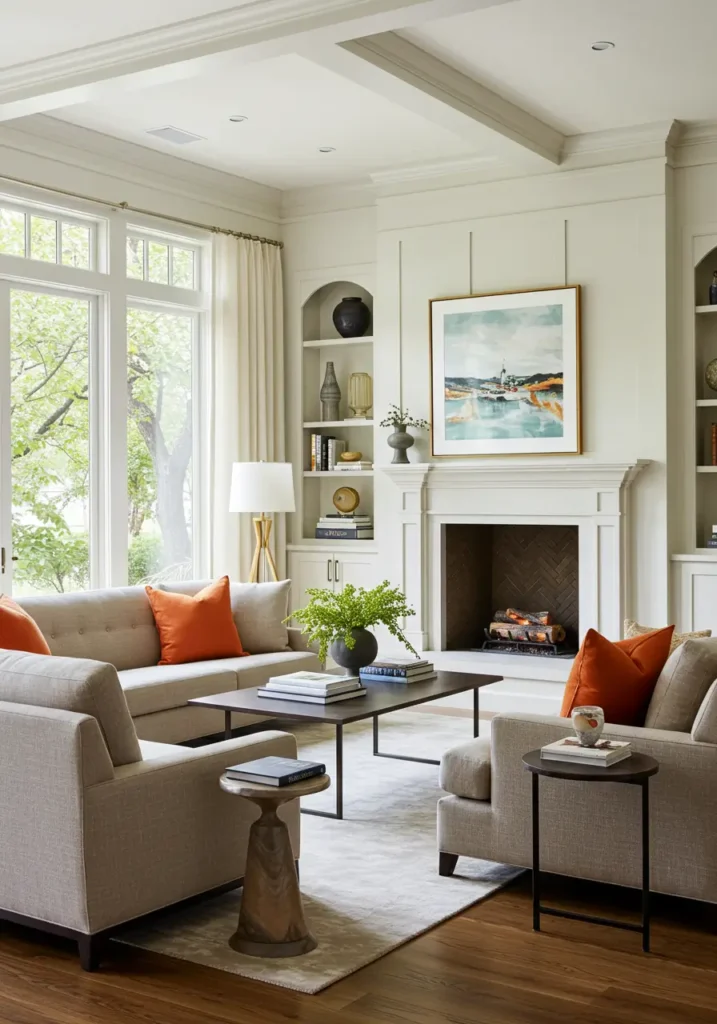
Expensive-looking spaces prioritize function and flow, with furniture arranged to encourage conversation and interaction. Instead of pushing all furniture against walls, create intimate seating areas that feel purposeful and inviting.
The key is ensuring people can comfortably converse without shouting across the room. Position seating pieces so they face each other or are angled toward a central focal point like a fireplace or coffee table. This arrangement creates a sense of intentionality that characterizes high-end design.
Proper Scale and Proportion
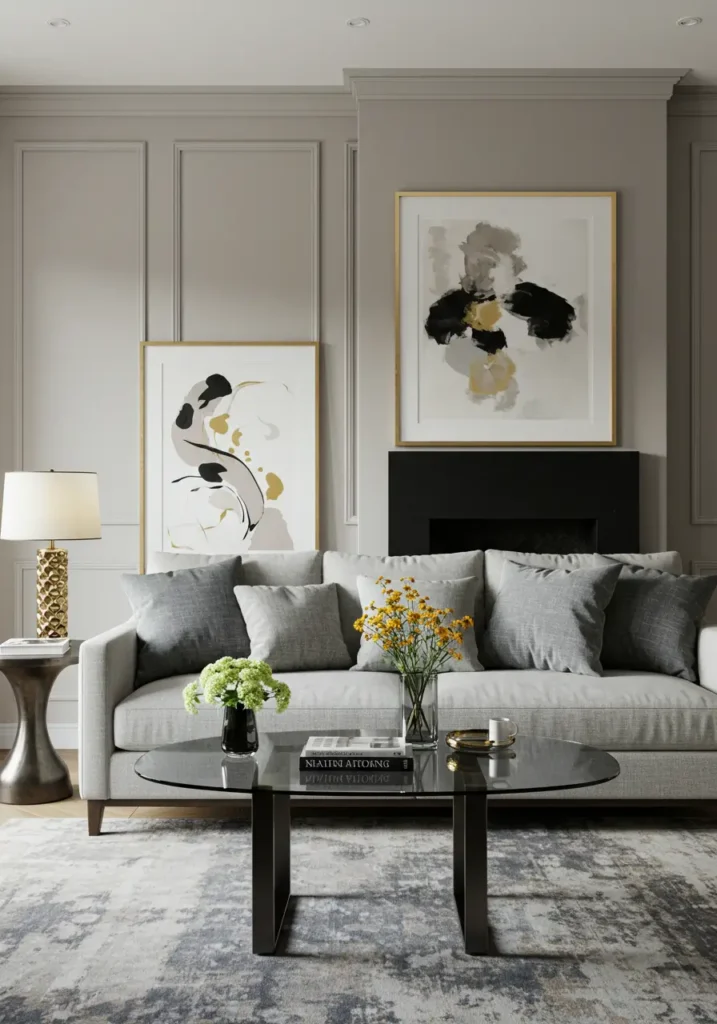
One of the most common mistakes in home decorating is choosing furniture that’s improperly scaled for the space. Expensive-looking rooms feature furniture that fits the room’s proportions perfectly, neither overwhelming the space nor appearing lost within it.
Large rooms can handle substantial furniture pieces, while smaller spaces benefit from furniture with visual lightness, such as pieces with legs that allow you to see underneath or glass-top tables that don’t visually consume floor space.
Creating Visual Balance
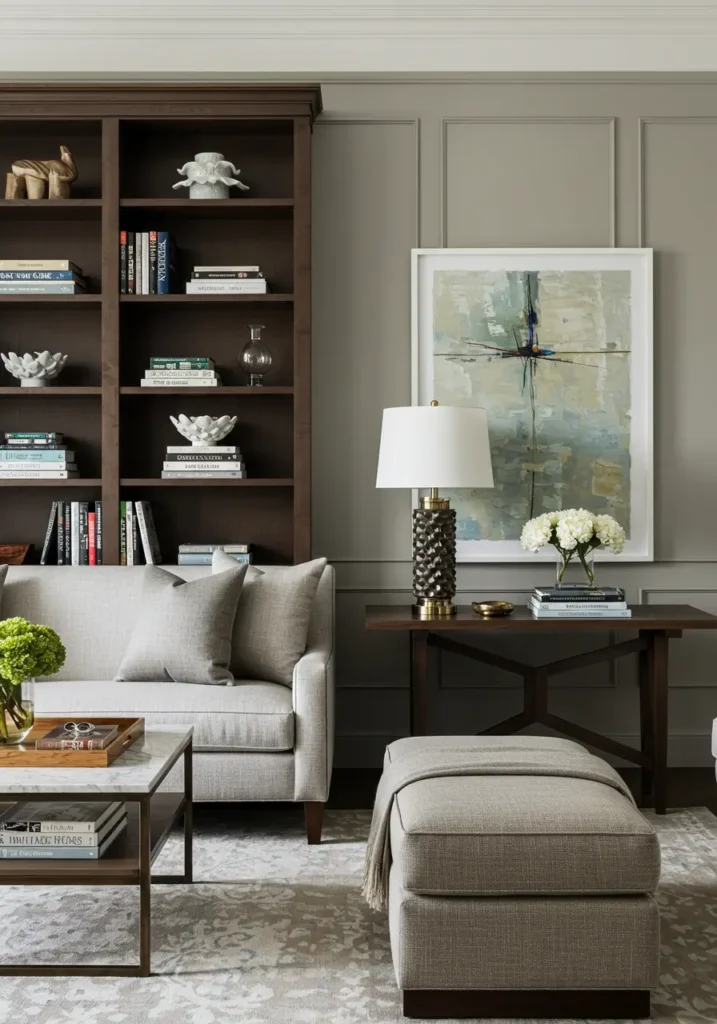
Professional designers understand the importance of visual weight distribution throughout a room. This doesn’t mean everything must be symmetrical, but rather that visual elements should be balanced to create harmony and stability.
Mix furniture heights, shapes, and textures to create interest while maintaining balance. A tall bookshelf on one side of a room might be balanced by a large piece of artwork and a substantial table lamp on the opposite side.
Traffic Flow Optimization
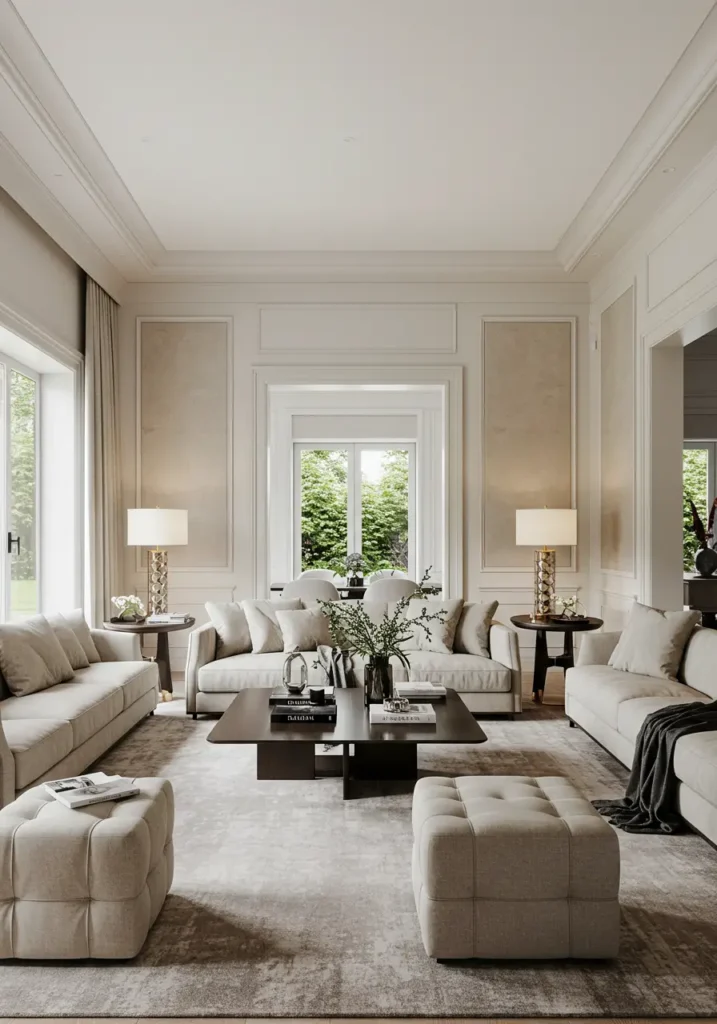
Expensive homes feel spacious and uncluttered, with clear pathways between rooms and around furniture. Ensure there’s enough space for people to move comfortably without bumping into furniture or feeling cramped.
A general rule is to maintain at least 30 inches of walking space around furniture and 14-18 inches of space between a coffee table and surrounding seating. These proportions create a sense of luxury and spaciousness regardless of the room’s actual size.
Textiles and Fabrics That Add Luxury
The textiles you choose can instantly elevate your home’s appearance and make it look far more expensive than the actual investment. High-quality fabrics, proper sizing, and strategic layering create the sophisticated look characteristic of luxury interiors.
Window Treatment Excellence

Nothing says expensive like properly hung, high-quality window treatments. Curtains should be hung high and wide – mount them close to the ceiling and extend them beyond the window frame to make windows appear larger and ceilings higher.
Choose curtains that puddle slightly on the floor or just graze it for a custom, luxurious appearance. Avoid curtains that hang several inches above the floor, as this immediately signals budget constraints and poor installation.
Invest in quality curtain rods and hardware. Substantial rods in brushed metals or rich finishes look far more expensive than thin, basic rods. The hardware is often visible and contributes significantly to the overall impression of quality.
Layering Textures and Patterns

Expensive-looking spaces feature rich layers of textures and carefully mixed patterns that create visual interest without chaos. Combine different fabric weights and textures – silk with linen, velvet with cotton, or leather with wool – to create depth and sophistication.
When mixing patterns, vary the scale and stick to a consistent color palette. A large-scale pattern might be paired with a medium geometric print and a small-scale texture or solid color. This creates visual interest while maintaining harmony.
Quality throw pillows, blankets, and area rugs can transform a space instantly. Choose a mix of textures and complement your color scheme while adding comfort and visual warmth to the room.
Art and Accessories That Make an Impact
The art and accessories you choose can make or break your home’s expensive appearance. The key is selecting pieces that feel intentional and sophisticated while avoiding the cluttered, collected-over-time look that characterizes many average homes.
Strategic Art Placement
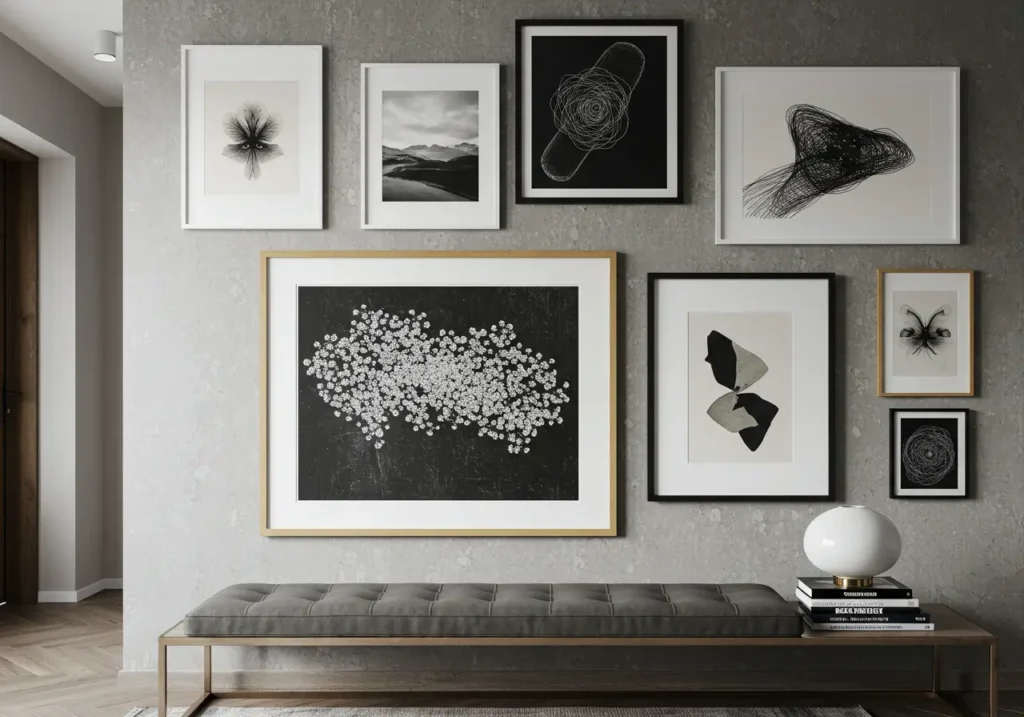
Hang artwork at the proper height – the center of the piece should be at eye level, typically 57-60 inches from the floor. This is the standard used in galleries and museums and immediately creates a professional, expensive appearance.
Scale matters enormously in art selection. One large piece often looks more expensive and sophisticated than several small pieces clustered together. If you’re grouping multiple pieces, treat them as one large unit and ensure proper spacing between them.
Consider creating gallery walls with consistent framing and matting for a curated, expensive appearance. Use frames in the same color family or material, and maintain consistent mat widths for a professional look.
Curated Accessories
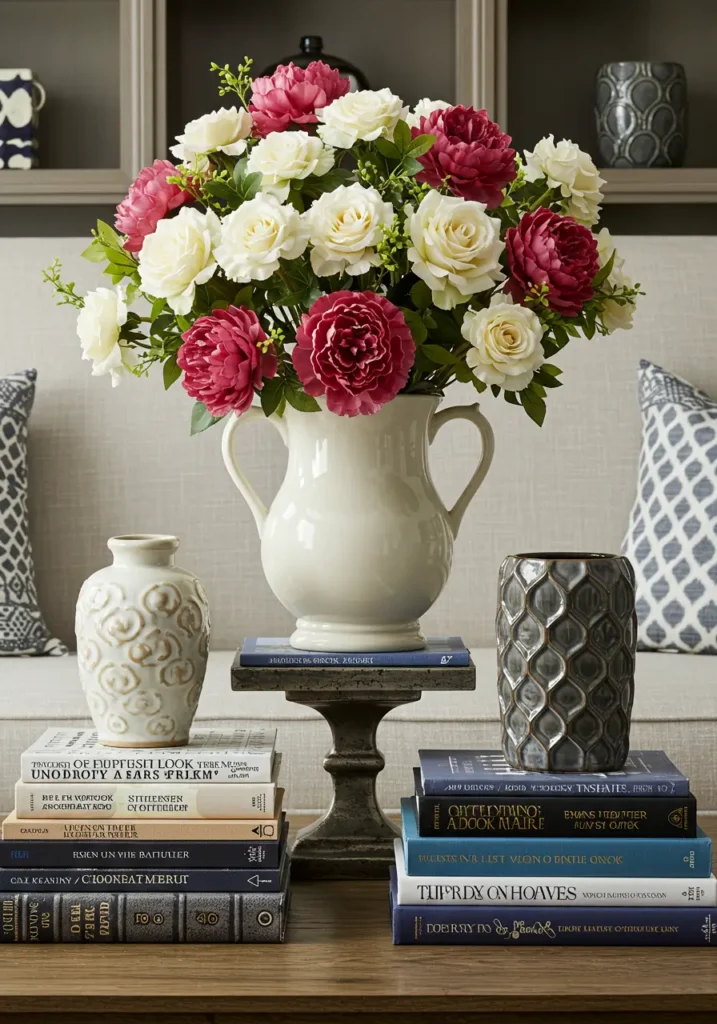
Less is more when it comes to accessories in expensive-looking homes. Choose a few high-quality pieces rather than many small items. Group accessories in odd numbers (groups of three or five) and vary heights for visual interest.
Fresh flowers or high-quality artificial arrangements add life and luxury to any space. Choose simple, elegant arrangements in beautiful vases rather than busy, colorful displays that can look amateur.
Books can serve as both decorative and functional accessories. Display books with attractive covers, and consider covering less attractive books in coordinating paper for a custom library appearance.
DIY Projects That Deliver Maximum Impact
Several DIY projects can dramatically improve your home’s appearance without requiring professional skills or major investment. These projects focus on details that make significant visual impact.
Upgrading Hardware and Fixtures
Replacing cabinet hardware, light switch plates, outlet covers, and door handles with higher-quality options can transform your home’s appearance instantly. Choose hardware in consistent finishes throughout connected spaces for a cohesive, professionally designed look.
Cabinet hardware should be proportional to the cabinet size and style. Larger cabinets can handle substantial hardware, while smaller drawers and doors look better with more delicate options. Consider the finish’s durability and how it coordinates with other metals in the space.
Upgrade basic contractor-grade fixtures with more substantial options. Even budget-friendly upgrades can look expensive if they’re well-proportioned and properly installed.
Crown Molding and Trim Work
Adding crown molding, chair rails, or upgrading existing trim can create the architectural interest characteristic of expensive homes. These details add visual weight and sophistication to otherwise plain walls.
If installing crown molding seems daunting, consider adhesive options that look authentic but require less skill to install. The key is ensuring clean, precise cuts and proper caulking for a professional appearance.
Paint all trim work in a consistent color throughout connected spaces. Bright white trim creates crisp, clean lines that look fresh and expensive, especially when contrasted with colored walls.
Also Read: Unlock Your Home’s Potential: Simple Strategies for a Better Living Space
Budget-Friendly Luxury Alternatives
Creating an expensive look doesn’t require expensive purchases. Understanding where to splurge and where to save allows you to maximize your decorating budget while achieving the sophisticated appearance you desire.
High-Impact, Low-Cost Changes
Paint is the most cost-effective way to transform any space. A fresh coat of paint in a sophisticated color can make rooms look completely different and far more expensive. Focus on high-visibility areas like entryways, living rooms, and main bedrooms for maximum impact.
Rearranging existing furniture costs nothing but can completely change a room’s feel and function. Experiment with different arrangements to find configurations that feel more spacious and intentional.
Deep cleaning and decluttering create an immediate impression of luxury and care. Expensive homes are impeccably maintained, so ensuring your space is spotless and organized is essential for achieving the look.
Strategic Splurges vs. Savings
Invest in items that have high visual impact and get daily use. A quality sofa, beautiful light fixture, or elegant area rug can anchor a room and make everything else look more expensive by association.
Save on accessories and decorative items that can be easily changed as trends evolve. Mix expensive key pieces with budget-friendly accessories to create a layered, collected-over-time appearance that feels authentic and sophisticated.
Consider shopping secondhand for unique pieces that add character without the high price tag. Vintage and antique items often have the quality and craftsmanship that signals expense and sophistication.
Room-by-Room Application Guide
Different rooms require different approaches to achieve an expensive look. Understanding the specific elements that matter most in each space helps prioritize your efforts and budget for maximum impact.
Living Room Luxury
The living room is often the first space guests see and spend time in, making it crucial for creating an expensive impression. Focus on creating a comfortable seating arrangement with quality throw pillows and a beautiful area rug that anchors the space.
Invest in good lighting with a mix of table lamps, floor lamps, and overhead options. Layer lighting allows you to create different moods and always ensures flattering illumination for the space and its occupants.
Add architectural interest with built-ins, floating shelves, or a statement accent wall. These elements create visual depth and suggest custom design work, even when achieved through DIY methods.
Kitchen Sophistication
Kitchens can look expensive with strategic updates that don’t require full renovation. Upgrade cabinet hardware, add under-cabinet lighting, and ensure countertops are clutter-free and sparkling clean.
Paint kitchen cabinets if they’re structurally sound but outdated in color. Choose sophisticated colors like navy, forest green, or classic white for a timeless, expensive appearance.
Add a beautiful backsplash or upgrade existing tile with paint or peel-and-stick options that mimic expensive materials. Focus on creating clean lines and professional-looking installation details.
Bedroom Elegance
Create a hotel-like atmosphere in the bedroom with quality bedding in neutral colors and varied textures. Layer different weights and materials for a luxurious, inviting appearance.
Ensure adequate lighting with bedside lamps that provide both ambient and task lighting. Table lamps on nightstands should be proportional to the furniture and provide enough light for reading.
Keep surfaces clutter-free and invest in storage solutions that maintain the room’s serene, uncluttered appearance. Expensive bedrooms feel like peaceful retreats rather than storage areas.
Maintaining Your Elevated Space
Once you’ve created an expensive-looking home, maintaining that appearance requires ongoing attention to detail and care. Expensive spaces are characterized by meticulous maintenance and attention to cleanliness and organization.
Daily Maintenance Habits
Develop daily habits that maintain your home’s elevated appearance without requiring major time investment. Make beds every morning, keep surfaces clear of clutter, and address spills or stains immediately to prevent permanent damage.
Regular dusting and vacuuming keep your space looking fresh and well-maintained. Pay special attention to light fixtures, artwork, and decorative accessories that can collect dust and lose their impact when not properly maintained.
Organize belongings so everything has a designated place. Expensive homes never look cluttered or disorganized, so developing systems for maintaining order is essential for preserving the sophisticated appearance you’ve created.
Seasonal Updates and Refreshers
Keep your space feeling fresh and current with small seasonal updates that don’t require major investment. Switch out throw pillows, add seasonal flowers, or rearrange accessories to create new focal points and maintain visual interest.
Address maintenance issues promptly to prevent small problems from becoming major ones. Touch up paint, tighten loose hardware, and replace burned-out bulbs immediately to maintain the polished appearance.
Periodically evaluate your space with fresh eyes and make adjustments as needed. What worked when you first decorated may need updating as your lifestyle changes or as pieces show wear from use.
Transforming Your Space Into a Luxurious Haven
Making your home look expensive is an achievable goal that doesn’t require unlimited resources or professional design services. By focusing on the fundamental elements that create luxury appeal – sophisticated color choices, quality lighting, proper furniture arrangement, and attention to detail – you can transform any space into an elegant, high-end environment.
The key to success lies in understanding that expensive-looking design is about making thoughtful, intentional choices rather than simply spending money. Quality over quantity, cohesive color schemes, and proper proportions matter far more than the actual cost of individual items.
Remember that creating an expensive-looking home is a process, not a destination. Start with the changes that will have the most impact, then gradually add elements that enhance and refine your space. Pay attention to details, maintain your improvements, and don’t be afraid to experiment with different arrangements and combinations.
With patience, creativity, and attention to the principles outlined in this guide, you can create a home that looks and feels luxurious while staying within your budget. Your space will not only impress guests but also provide you with a beautiful, comfortable environment that reflects your personal style and enhances your daily life.
Frequently Asked Questions
What’s the most cost-effective way to make my home look expensive?
Paint is the single most cost-effective way to transform your home’s appearance. Choose sophisticated neutral colors for walls and consider painting existing furniture or cabinets to give them a fresh, expensive look. Combine this with strategic decluttering and deep cleaning for maximum impact with minimal investment.
How can I make a small room look more expensive and spacious?
Use light colors on walls and ceilings to create the illusion of space. Hang curtains high and wide to make windows appear larger. Choose furniture with legs to create visual flow underneath, and use mirrors strategically to reflect light and create depth. Keep clutter to a minimum and ensure proper lighting throughout the space.
Should I follow current trends to make my home look expensive?
Focus on timeless elements rather than fleeting trends to create lasting luxury appeal. Classic color schemes, quality materials, and proper proportions never go out of style. You can incorporate trends through easily changeable accessories like throw pillows, artwork, or seasonal decorations without committing to expensive trend-based renovations.
How important is lighting in creating an expensive look?
Lighting is crucial for creating luxury appeal. Layer different types of lighting – ambient, task, and accent – to create depth and ambiance. Invest in dimmer switches and quality fixtures, even if budget-friendly. Proper lighting can make inexpensive furniture and decor appear far more valuable and sophisticated.
Can I mix different design styles and still achieve an expensive look?
Yes, but maintain consistency in color palette, quality level, and scale throughout your home. Successful mixing requires a unifying element like consistent hardware finishes, similar wood tones, or a cohesive color scheme. The key is ensuring each piece looks intentional rather than randomly collected, regardless of style differences.
